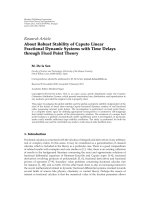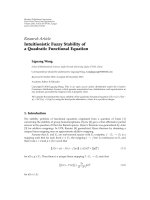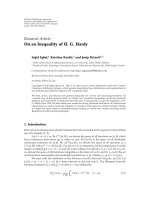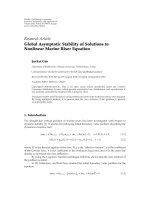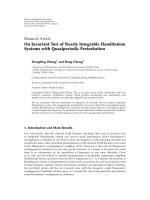Báo cáo hóa học: " Research Article On T -Stability of Picard Iteration in Cone Metric Spaces" potx
Bạn đang xem bản rút gọn của tài liệu. Xem và tải ngay bản đầy đủ của tài liệu tại đây (462.83 KB, 6 trang )
Hindawi Publishing Corporation
Fixed Point Theory and Applications
Volume 2009, Article ID 751090, 6 pages
doi:10.1155/2009/751090
Research Article
On T-Stability of Picard Iteration in
Cone Metric Spaces
M. Asadi,
1
H. Soleimani,
1
S. M. Vaezpour,
2, 3
and B. E. Rhoades
4
1
Department of Mathematics, Science and Research Branch, Islamic Azad University (IAU),
Tehran 14778 93855, Iran
2
Department of Mathematics, Amirkabir University of Technology, Tehran 15916 34311, Iran
3
Department of Mathematics, Newcastle University, Newcastle, NSW 2308, Australia
4
Department of Mathematics, Indiana University, Bloomington, IN 46205, USA
Correspondence should be addressed to S. M. Vaezpour,
Received 28 March 2009; Revised 28 September 2009; Accepted 19 October 2009
Recommended by Brailey Sims
The aim of this work is to investigate the T-stability of Picard’s iteration procedures in cone metric
spaces and give an application.
Copyright q 2009 M. Asadi et al. This is an open access article distributed under the Creative
Commons Attribution License, which permits unrestricted use, distribution, and reproduction in
any medium, provided the original work is properly cited.
1. Introduction and Preliminary
Let E be a real Banach space. A nonempty convex closed subset P ⊂ E is called a cone in E if
it satisfies the following:
i P is closed, nonempty, and P
/
{0},
ii a, b ∈ R,a,b≥ 0, and x,y ∈ P imply that ax by ∈ P,
iii x ∈ P and −x ∈ P imply that x 0.
The space E can be partially ordered by the cone P ⊂ E; by defining, x ≤ y if and only if
y − x ∈ P. Also, we write x y if y − x ∈ int P, where int P denotes the interior of P.
A cone P is called normal if there exists a constant K>0 such that 0 ≤ x ≤ y implies
x≤
Ky.
In the following we always suppose that E is a real Banach space, P is a cone in E,and
≤ is the partial ordering with respect to P.
Definition 1.1 see 1.LetX be a nonempty set. Assume that the mapping d : X × X → E
satisfies the following:
2 Fixed Point Theory and Applications
i 0 ≤ dx, y for all x, y ∈ X and dx, y0 if and only if x y,
ii dx, ydy, x for all x, y ∈ X,
iii dx, y ≤ dx, zdz, y for all x,y, z ∈ X.
Then d is called a cone metric on X,andX, d is called a cone metric space.
Definition 1.2. Let T : X → X be a map for which there exist real numbers a, b,c satisfying
0 <a<1, 0 <b<1/2, 0 <c<1/2. Then T is called a Zamfirescu operator if, for each pair
x, y ∈
X, T satisfies at least one of the following conditions:
1 dTx,Ty ≤ adx, y,
2 dTx,Ty ≤ bdx, Txdy,Ty,
3 dTx,Ty ≤ cdx, Tydy, Tx.
Every Zamfirescu operator T satisfies the i nequality:
d
Tx,Ty
≤ δd
x, y
2δd
x, Tx
1.1
for all x, y ∈ X, where δ max{a, b/1 − b,c/1 − c},with0<δ<1. For normed spaces see
2.
Lemma 1.3 see 3. Let {a
n
} and {b
n
} be nonnegative real sequences satisfying the following
inequality:
a
n1
≤
1 − λ
n
a
n
b
n
, 1.2
where λ
n
∈ 0, 1, for all n ≥ n
0
,
∞
n1
λ
n
∞, and b
n
/λ
n
→ 0 as n →∞. Then lim
n →∞
a
n
0.
Remark 1.4. Let {a
n
} and {b
n
} be nonnegative real sequences satisfying the following
inequality:
a
n1
≤ λa
n−m
b
n
, 1.3
where λ ∈ 0, 1, for all n ≥ n
0
and for some positive integer number m.Ifb
n
→ 0asn →∞.
Then lim
n →∞
a
n
0.
Lemma 1.5. Let P be a normal cone with constant K, and let {a
n
} and {b
n
} be sequences in E
satisfying the following inequality:
a
n1
≤ ha
n
b
n
, 1.4
where h ∈ 0, 1 and b
n
→ 0 as n →∞. Then lim
n →∞
a
n
0.
Proof. Let m be a positive integer such that h
m
K<1. By recursion we have
a
n1
≤ b
n
hb
n−1
··· h
m
b
n−m
h
m1
a
n−m
,
1.5
Fixed Point Theory and Applications 3
so
a
n1
≤ K
b
n
hb
n−1
··· h
m
b
n−m
h
m1
K
a
n−m
,
1.6
and then by Remark 1.4 a
n
→0. Therefore a
n
→ 0.
2. T-Stability in Cone Metric Spaces
Let X, d be a cone metric space, and T a self-map of X.Letx
0
be a point of X, and assume
that x
n1
fT, x
n
is an iteration procedure, involving T, which yields a sequence {x
n
} of
points from X.
Definition 2.1 see 4. The iteration procedure x
n1
fT, x
n
is said to be T-stable with
respect to T if {x
n
} converges to a fixed point q of T and whenever {y
n
} is a sequence in X
with lim
n →∞
dy
n1
,fT, y
n
0 we have lim
n →∞
y
n
q.
In practice, such a sequence {y
n
} could arise in the following way. Let x
0
be a point in
X.Setx
n1
fT, x
n
.Lety
0
x
0
.Nowx
1
fT, x
0
. Because of rounding or discretization
in the function T, a new value y
1
approximately equal to x
1
might be obtained instead of the
true value of fT, x
0
. Then to approximate y
2
, the value fT,y
1
is computed to yield y
2
,
an approximation of fT, y
1
. This computation is continued to obtain {y
n
} an approximate
sequence of {x
n
}.
One of the most popular iteration procedures for approximating a fixed point of T is
Picard’s iteration defined by x
n1
Tx
n
. If the conditions of Definition 2.1 hold for x
n1
Tx
n
,
then we will say that Picard’s iteration is T-stable.
Recently Qing and Rhoades 5 established a result for the T-stability of Picard’s
iteration in metric spaces. Here we are going to generalize their result to cone metric spaces
and present an application.
Theorem 2.2. Let X, d be cone metric space, P a normal cone, and T : X → X with FT
/
∅. If
there exist numbers a ≥ 0 and 0 ≤ b<1, such that
d
Tx,q
≤ ad
x, Tx
bd
x, q
2.1
for each x ∈ X, q ∈ FT and in addition, whenever {y
n
} is a sequence with dy
n
,Ty
n
→ 0 as
n →∞, then Picard’s iteration is T-stable.
Proof. Suppose {y
n
}⊆X, c
n
dy
n1
,Ty
n
and c
n
→ 0. Weshallshowthaty
n
→ q. Since
d
y
n1
,q
≤ d
y
n1
,Ty
n
d
Ty
n
,q
≤ c
n
ad
y
n
,Ty
n
bd
y
n
,q
, 2.2
if we put a
n
: dTy
n
,q and b
n
: c
n
ady
n
,Ty
n
in Lemma 1.5, then we have y
n
→ q.
Note that the fixed point q of T is unique. Because if p is another fixed point of T, then
d
p, q
d
Tp,q
≤ ad
p, Tp
bd
p, q
bd
p, q
, 2.3
which implies p q.
4 Fixed Point Theory and Applications
Corollary 2.3. Let X, d be a cone metric space, P a normal cone, and T : X → X with q ∈ FT.
If there exists a number λ ∈ 0, 1, such that dTx,Ty ≤ λdx, y, for each x, y ∈ X, then Picard’s
iteration is T-stable.
Corollary 2.4. Let X, d be a cone metric space, P a normal cone, and T : X → X is a Zamfirescu
operator with FT
/
∅ and whenever {y
n
} is a sequence with dy
n
,Ty
n
→ 0 as n →∞,then
Picard’s iteration is T-stable.
Definition 2.5 see 6.LetX, d be a cone metric space. A map T : X → X is called a
quasicontraction if for some constant λ ∈ 0, 1 and for every x, y ∈ X, there exists u ∈
CT; x, y ≡{dx, y,dx, Tx,dy, Ty,dx, Ty,dy, Tx}, such that dTx,Ty ≤ λu.
Lemma 2.6. If T is a quasicontraction with 0 <λ<1/2,thenT is a Zamfirescu operator and so
satisfies 2.1.
Proof. Let λ ∈ 0
, 1/2 for every x, y ∈ X we have dTx,Ty ≤ λu for some u ∈ CT; x, y. In
the case that u dx, Ty we have
d
Tx,Ty
≤ λd
x, Ty
≤ λd
x, Tx
λd
Tx,Ty
. 2.4
So
d
Tx,Ty
≤
λ
1 − λ
d
x, Tx
≤ 2
λ
1 − λ
d
x, Tx
λ
1 − λ
d
x, y
.
2.5
Put δ : λ/1 − λ so 0 <δ<1. The other cases are similarly proved. Therefore T is a
Zamfirescu operator.
Theorem 2.7. Let X, d be a nonempty complete cone metric space, P be a normal cone, and T a
quasicontraction and self map of X with some 0 <λ<1/2. Then Picard’s iteration is T-stable.
Proof. By 6, Theorem 2.1, T has a unique fixed point q ∈ X. Also T satisfies 2.1.Soby
Theorem 2.2 it is enough to show that dy
n
,Ty
n
→ 0. We have
d
y
n
,Ty
n
≤ d
y
n
,Ty
n−1
d
Ty
n−1
,Ty
n
. 2.6
Put b
n
: dy
n
,Ty
n
,c
n
: dy
n1
,Ty
n
and d
n
: dTy
n−1
,Ty
n
. Therefore c
n
→ 0asn →∞
and
b
n
≤ c
n−1
d
n
≤ c
n−1
λu
n
, 2.7
where
u
n
∈ C
T, y
n−1
,y
n
d
y
n−1
,y
n
,d
y
n−1
,Ty
n−1
,d
y
n
,Ty
n
,d
y
n−1
,Ty
n
,d
y
n
,Ty
n−1
.
2.8
Fixed Point Theory and Applications 5
Hencewehaveu
n
b
n
or u
n
≤ sb
n−1
lc
n−1
where s 0, 1or1/1 − λ and l 1or1 λ.
Therefore by 2.7, b
n
≤ λl 1c
n−1
λsb
n−1
by 0 ≤ λs < 1. Now by Lemma 1.5 we have
b
n
→ 0.
3. An Application
Theorem 3.1. Let X :C0, 1, R with f
∞
: sup
0≤x≤1
|fx| for f ∈ X and let T be a self map
of X defined by Tfx
1
0
Fx, ftdt where
a F : 0, 1 × R → R is a continuous function,
b the partial derivative F
y
of F with respect to y exists and |F
y
x, y|≤L for some L ∈ 0, 1,
c for every real number 0 ≤ a<1 one has ax ≤ Fx, ay for every x, y ∈ 0, 1.
Let P : {x, y ∈ R
2
| x, y ≥ 0} be a normal cone and X, d the complete cone metric space defined
by df, gf − g
∞
,αf − g
∞
where α ≥ 0. Then,
i Picard’s iteration is T-stable if 0 ≤ L<1/2,
ii Picard’s iteration fails to be T-stable if 1/2 ≤ L<1 and
1
0
Fx, tdt
/
x.
Proof. i We have T being a continuous quasicontraction map with 0 ≤ λ : L<1/2; so by
Theorem 2.7, Picard’s iteration is T-stable.
ii Put y
n
x : nx/n 1 so y
n
∈ X and dy
n
,h → 0, where hxx. Also
dy
n1
,Ty
n
→ 0, since
y
n1
− Ty
n
∞
sup
0≤x≤1
n 1
n 2
x −
1
0
F
x,
nt
n 1
dt
≤ sup
0≤x≤1
n 1
n 2
x −
nx
n 1
−→ 0,
3.1
as n →∞. But y
n
→ h and h is not a fixed point for T. Therefore Picard’s iteration is not
T-stable.
Example 3.2. Let F
1
x, y : x y/4andF
2
x, y : x y/2. Therefore F
1
and F
2
satisfy the
hypothesis of Theorem 3.1 where F
1
has property i and F
2
has property ii. So the self maps
T
1
,T
2
of X defined by T
1
fxx 1/4
1
0
ftdt and T
2
fxx 1/2
1
0
ftdt have unique
fixed points but Picard’s iteration is T-stable for T
1
but not T-stable for T
2
.
References
1 L G. Huang and X. Zhang, “Cone metric spaces and fixed point theorems of contractive mappings,”
Journal of Mathematical Analysis and Applications, vol. 332, no. 2, pp. 1468–1476, 2007.
2 X. Zhiqun, “Remarks of equivalence among Picard, Mann, and Ishikawa iterations in normed spaces,”
Fixed Point Theory and Applications, vol. 2007, Article ID 61434, 5 pages, 2007.
3 F. P. Vasilev, Numerical Methodes for Solving Extremal Problems, Nauka, Moscow, Russian, 2nd edition,
1988.
4 A. M. Harder and T. L. Hicks, “Stability results for fixed point iteration procedures,” Mathematica
Japonica, vol. 33, no. 5, pp. 693–706, 1988.
6 Fixed Point Theory and Applications
5 Y. Qing and B. E. Rhoades, “T-stability of Picard iteration in metric spaces,” Fixed Point Theory and
Applications, vol. 2008, Article ID 418971, 4 pages, 2008.
6 D. Ili
´
candV.Rako
´
cevi
´
c, “Quasi-contraction on a cone metric space,” Applied Mathematics Letters, vol.
22, no. 5, pp. 728–731, 2009.

